BY BANNOCKBURN GLOBAL FOREX , LLC
The USD was mixed in August, losing a little ground against a strong EUR but gaining modestly against GBP and the CAD. After initially recovering slightly after heavy losses in July, the USD made new lows both against the EUR and on a trade-weighted basis at the end of the month in the aftermath of the central bank symposium at Jackson Hole. Market hopes that ECB president Draghi would indicate concern at the strength of the EUR proved unfounded, sending EUR/USD above 1.20 to its highest level since January 2015. The lack of any indication of impending monetary policy tightening from Fed Chair Yellen at the same event also weighed on the USD. However, stronger than expected US Q2 GDP data and ADP employment data helped the USD recover by the end of the month, leaving the USD index little changed. Geopolitical tensions with North Korea also caused substantial market volatility through the month. Although there was no clear net effect on the USD, the safe haven currencies benefited sharply, albeit only for brief periods.
One-Year USD Index:
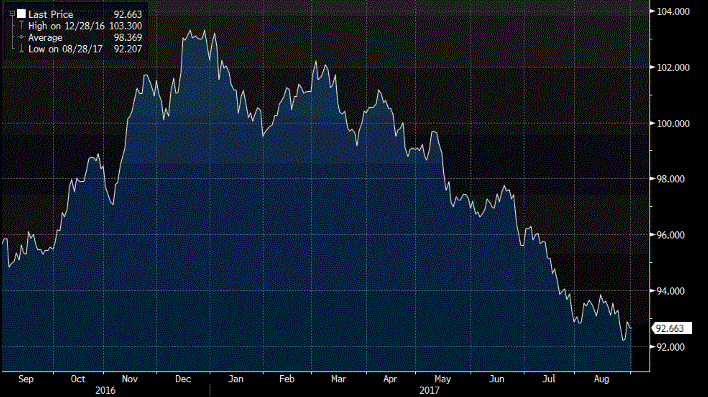
Outlook for September
1) ECB meeting September 7
The market will be focused on any plans the ECB announces for the continuation of their asset purchases in 2018. They are committed to continuing the current pace of buying until the end of this year, but the improvement in the Eurozone economy and the indications from Draghi that the risks to underlying inflation are becoming more balanced means the case for further monetary policy easing has become much weaker. While the ECB are committed to asset purchases until the end of 2017, few expect them to cease abruptly at that point, and most expect some sort of “tapering” of purchases in the early part of 2018. It may be that this schedule is announced at the September meeting, though the ECB could delay an announcement until October. Markets expect some plan involving smaller asset purchases for 6 months or so into 2018, so variations around that would trigger market reaction. The market will also be on watch for any comments from Draghi about the recent strength of the EUR. The lack of any significant protest at the last meeting or in his speech at the Jackson Hole symposium have been seen by some as a “green light” for EUR strength. He is unlikely to change his tune this time by explicitly bemoaning EUR strength, but may nevertheless make it clear that a stronger EUR means tighter financial conditions and lower inflation, other things equal. There have been some comments from unnamed ECB sources in recent days to this effect. The implication of this would be that there is therefore less need to reduce (or taper) monetary policy accommodation. Such comments could prove EUR negative in the short run.
2) FOMC meeting September 19/20
The market has no expectation of a Fed rate hike at the September meeting, in part because growth has been slightly disappointing this year – the latest better Q2 data notwithstanding – but mostly because inflation has remained subdued, with the main Fed target measure the PCE deflator at just 1.4% in July. However, the Fed is likely to start its process of reducing its balance sheet in September, with the announcement expected at this meeting. The details of the process are clear, but the market impact remains uncertain. In practice, the impact is unlikely to be initially large, but the risk is that the start of the unwinding triggers a selloff in the bond market and a consequent rise in US yields and a steepening of the yield curve. This could prove USD positive, but the market will also be on alert for any comments about the likelihood of a Fed hike in December. Currently this is seen as only around a 35% chance, so the risks may be that the market prices a December hike as more probable on upbeat Fed comments. However, it is unlikely there will be any very clear cut guidance as the impact from Hurricane Harvey and the Trump administration’s fiscal plans remain uncertain, not to mention geopolitical uncertainties related to North Korea.
3) Brexit negotiations
So far, negotiations have not gone well. Agreement hasn’t really been reached on anything yet, and positions appear to be becoming more entrenched. GBP has suffered somewhat against the EUR as a result, though much of the EUR strength has been about Eurozone economics and policy rather than Brexit. The most likely news in September is probably that there is no news, with talks continuing to drag on without result. However, with the market now expecting very little, the risk relative to expectations may now be that there is some progress creating some upside risk for GBP.
CURRENCY OUTLOOKS:
EUR/USD
After a modest correction in early August EUR/USD made new highs above 1.20 in late August after the Jackson Hole symposium, helped also by a rise in tension with North Korea. But stronger US data and some reports of concerns about EUR strength from unnamed ECB members helped a modest USD recovery by the end of the month. The outlook for September is likely to depend mainly on the ECB meeting on September 7. While Draghi seems unlikely to formally protest EUR strength, the strength of the EUR may mean that the tapering plans for 2018 (reducing monetary accommodation), if announced, are more modest than the market is anticipating. The EUR may consequently struggle to extend gains and some slippage towards 1.15 may be seen, especially if US yields rise in response to the beginning of the Fed’s balance sheet reduction. But EUR/USD losses below 1.15 are likely to be hard to achieve, as expectations of tapering will increase the weaker the EUR gets. It is likely that EUR/USD is now in a long term uptrend unless we see some clear aggressive action on US fiscal policy, or a shock from elsewhere, though for now we may see a period of consolidation in the 1.15-120 range.
Three-Month EUR/USD:
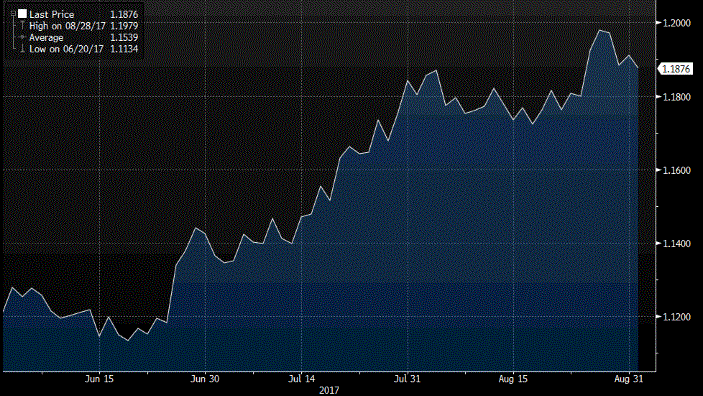
GBP/USD
GBP/USD fell back through August in part in response to the MPC meeting and Inflation Report on August 3rd in which the Bank of England reduced their growth expectations. While the MPC remained split, the split was 6-2 rather than 5-3 in favor of keeping rates unchanged, with the new MPC member Silvana Tenreyro joining the majority and Kristin Forbes leaving the committee after voting for a hike in June. In addition, news on the Brexit negotiations has not been favorable, with no apparent progress, and GBP has been particularly under pressure against the EUR, though has also fallen back against the USD. In the absence of positive Brexit surprises, it is hard to see a case for GBP to move back above 1.30, and the risk in September look more likely to be towards testing the June low of 1.2590 than the August high at 1.3270.
Three-Month GBP/USD:
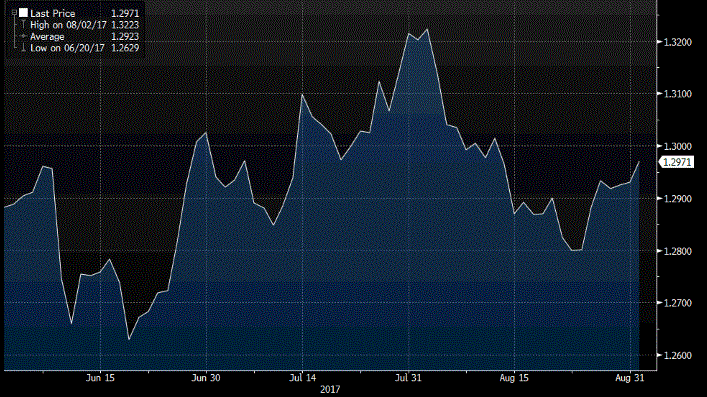
USD/CAD
After sharp gains in July the CAD stabilized in August and may now be finding a new range rather than embarking on a new trend. From a longer term perspective current levels are close to fair value for the CAD, and with the US and Canadian economies and monetary policy cycles looking close to being in sync, it seems likely that we will now see a period of consolidation in the mid-1.20s in the absence of major moves in the oil price. The Bank of Canada meeting this month is unlikely to produce any change in policy. Risks may be slightly weighted to the downside for USD/CAD if geopolitical tensions fade, with a break below 1.24 opening up potential towards 1.20.
Three-Month USD/CAD:

USD/MXN
USD/MXN was quite steady through August and appears to have established a new range of 17.45/50-18.00/05 for now. The lack of real action from the Trump administration on tax or protectionist initiatives suggests the risks are still mostly on the upside for the MXN if geopolitical concerns calm down, with the MXN probably less vulnerable to rising US yields that could result from the beginning of Fed balance sheet reduction than most other currencies, given its existing yield advantage.
Three-Month USD/MXN:
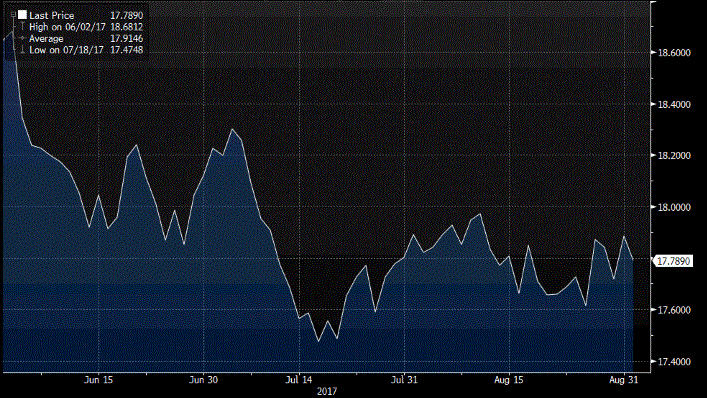
USD/JPY
The JPY managed sharp gains for short periods in August, driven by geopolitical concerns related to North Korea. Even though it was the launching of missiles over Japan that triggered the concerns, the JPY gained as it always tends to when risk appetite dips, given its status as the main funding currency for risk positive trades. However, gains proved relatively short lived, as did equity market weakness, and in the absence of new geopolitical concerns the JPY looks likely to weaken once again against a background of improving global growth and rising yields around the world. There is good support at 108 and scope for USD gains towards July highs at 114.
Three-Month USD/JPY:
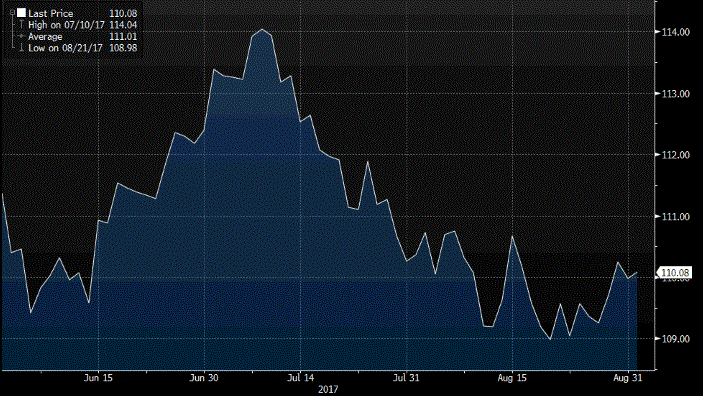
Compliments of Bannockburn Global Forex, a member of EACC
![European American Chamber of Commerce New York [EACCNY] | Your Partner for Transatlantic Business Resources](https://eaccny.com/wp-content/uploads/2020/06/eaccny-logo.png)





